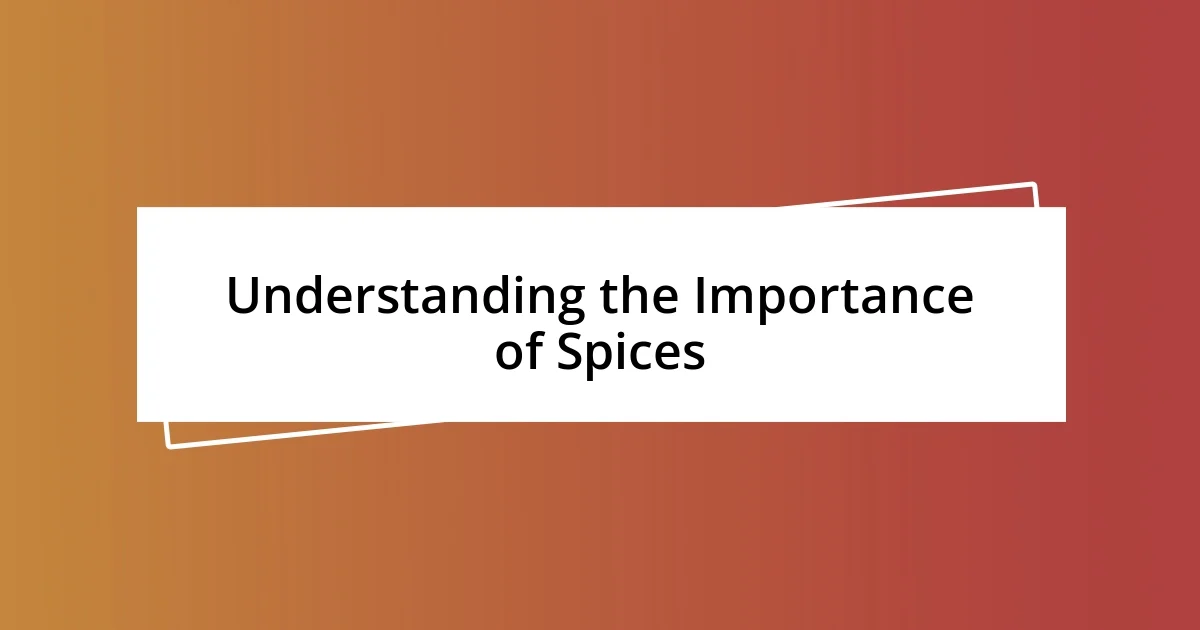Key takeaways:
- Spices enhance flavor, confer health benefits, and connect us to cultural traditions.
- Choosing quality spices involves checking freshness, opting for whole spices, and trusting your senses.
- Effective spice usage includes timing, toasting spices, and layering, which significantly elevates the flavor of dishes.

Understanding the Importance of Spices
Spices are the heartbeat of any cuisine, transforming bland ingredients into something extraordinary. I remember that moment I sprinkled a pinch of cumin into a pot of stew; it was as if the entire dish came alive, with warmth and complexity emerging. How often do we take for granted this simple magic that spices bring to our meals?
Beyond flavor, spices are packed with health benefits that can’t be overlooked. Did you know that turmeric contains curcumin, known for its anti-inflammatory properties? When I started incorporating more turmeric into my diet, I noticed a significant difference in my overall well-being. Isn’t it incredible that something so small can have such a profound impact on our health?
Moreover, spices carry rich cultural histories that tell stories of connection and tradition. Each time I use a spice blend passed down from my grandmother, I feel a sense of heritage enveloping me. Isn’t it fascinating how a simple sprinkle can connect us to centuries of culinary tradition? Understanding this importance not only enhances our cooking but also deepens our appreciation for the journey that each spice has taken to reach our kitchens.

Common Spices and Their Benefits
When I think of common spices, I can’t help but reflect on the power of garlic. Not only does it add a punch of flavor to nearly any dish, but garlic is also known to boost the immune system. The first time I tried roasting garlic cloves, the sweet, caramelized scent wafted through my kitchen, and I remember thinking, “How did I ever cook without this?”
Cinnamon is another spice that holds a special place in my heart. Beyond its delightful aroma that brings comfort, it’s packed with antioxidants and can help reduce inflammation. I often sprinkle it on my morning oatmeal, and each bite transports me back to cozy winter mornings spent at my grandmother’s kitchen table, where the warmth and spice filled the air just like love.
Lastly, cayenne pepper is a spice that brings a bit of heat to the dance floor of flavor. It’s not just for those who enjoy a kick in their food; it may also boost metabolism. The first time I added it to a chili recipe after a friend raved about its benefits, I felt a surge of excitement as I tasted the vibrant complexity it brought. It taught me that embracing a little boldness in cooking can yield delicious and healthful surprises.
| Spice | Benefits |
|---|---|
| Garlic | Boosts immune system; adds flavor |
| Cinnamon | Packed with antioxidants; helps reduce inflammation |
| Cayenne Pepper | May boost metabolism; adds heat |

How to Choose Quality Spices
Selecting quality spices can feel like hunting for treasures. I’ve learned through countless shopping trips that freshness is paramount. When I pick up a spice jar, I always give it a good sniff. If the aroma doesn’t hit me, I’m usually hesitant to buy it.
Here are a few tips to ensure you’re choosing the best spices:
- Check the Packaging Date: Spices don’t stay fresh forever. I aim for jars with a recent packaging date, ideally within the last six months.
- Look for Whole Spices: Whenever possible, I prefer whole spices over ground ones. They have a longer shelf life and deliver more potent flavors when freshly ground.
- Inspect the Color: Vibrant colors indicate freshness. Dull hues often suggest aging—something I always try to avoid.
- Choose Reputable Brands: I find comfort in knowing where my spices come from, so I lean towards brands known for quality.
- Trust Your Senses: Don’t underestimate the power of your nose. A rich, strong fragrance usually means you’re getting a quality product.
The freshness and quality of spices can significantly transform your dishes, and when I incorporate well-chosen spices into my cooking, it doesn’t just add flavor—it adds joy and passion to every meal. I remember a time when I sourced saffron from a boutique spice shop rather than the supermarket; the deep, earthy scent filled my kitchen, and that risotto I made was nothing short of magic. Choosing quality spices is not just a practical decision; it’s an emotional investment in the food I love to create.

Best Techniques for Using Spices
When it comes to using spices effectively, timing is everything. I’ve often noticed that adding spices at different stages of cooking can dramatically alter the flavor profile of a dish. For example, if I sprinkle in cumin while sautéing onions, it creates a deep, aromatic base that is hard to replicate later on. Have you ever experienced that moment of revelation when you realize the right timing can elevate your cooking to a whole new level?
Another technique I employ often is to toast my spices before using them. This simple step unlocks the essential oils within, enhancing their flavor and aroma. I remember when I first toasted coriander seeds—what a game changer! The scent filled the kitchen, wrapping around me like a warm hug. It made my curry truly unforgettable. If you haven’t tried this yet, I encourage you to step out of your comfort zone and give it a go; it’s a small effort for a big impact.
Don’t forget about layering spices. This technique has taught me that balance is key. For instance, when making a spice rub for chicken, I combine sweet, smoky, and savory elements to create a more dynamic dish. Think about your palate: how can different spices serve your taste preferences? I find that experimenting with layering helps me discover exciting, unexpected flavors that keep my meals fresh and exciting. What’s your favorite layering combination?

Cooking Methods That Enhance Flavors
One of the most fascinating cooking methods I’ve discovered is the slow-cooking technique. There’s something magical about letting spices meld over time. When I simmer a chili for hours, the flavors deepen, creating a complexity that’s downright delightful. Have you ever tasted a chili that simmered all day? It’s a comforting experience, almost like wrapping yourself in a warm blanket.
Grilling, too, has been a game changer for enhancing spice flavors. When I grill my meat with a spice rub, those heat-kissed spices transform into a smoky, charred melody. I vividly recall the first summer I marinated chicken with a blend of paprika and garlic, then tossed it on the grill. As it cooked, the aroma wafted into the air, drawing friends and family to the patio. That charred exterior, combined with the juicy inside, created a dance of flavor that I still chase during every backyard BBQ.
I’ve also embraced the art of infusing oils with spices. When I first experimented with garlic oil, I simply heated olive oil with crushed garlic cloves. My kitchen was enveloped in an aromatic embrace, and I was amazed at how a simple drizzle could elevate my dishes. Have you tried infusing your oils? It’s a wonderful way to introduce a depth of flavor without overcomplicating the dish—simplicity at its best.

Storage Tips for Spices
When it comes to storing spices, I’ve learned that keeping them in airtight containers is a must. I often use glass jars because they not only look great on my spice rack but also protect the spices from moisture and light. Have you ever opened a jar only to find your spices have lost their vibrant color? That’s usually a sign they’ve been exposed to the elements.
I’ve also realized that placing spices in a cool, dark place can greatly extend their shelf life. For me, the pantry has become a favorite spot, away from the heat of the stove. I once neglected a jar of turmeric, leaving it near the window for months, and, boy, did it lose its punch! Now, I make it a habit to check my spice collection regularly to keep things fresh and flavorful.
Labeling my spices has been another simple yet effective tip. I can’t tell you how often I’ve rummaged through my collection, trying to remember what’s what. By using a white label maker, I clearly mark the name and date I purchased them. In doing so, I not only maintain a neat spice cabinet but also avoid those embarrassing moments of seasoning my dishes with a spice that’s gone stale. Have you thought about how much easier cooking could be with a well-organized spice shelf?














